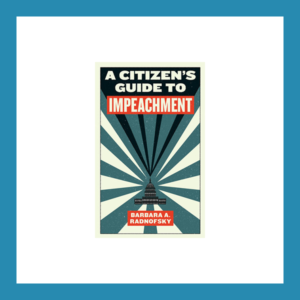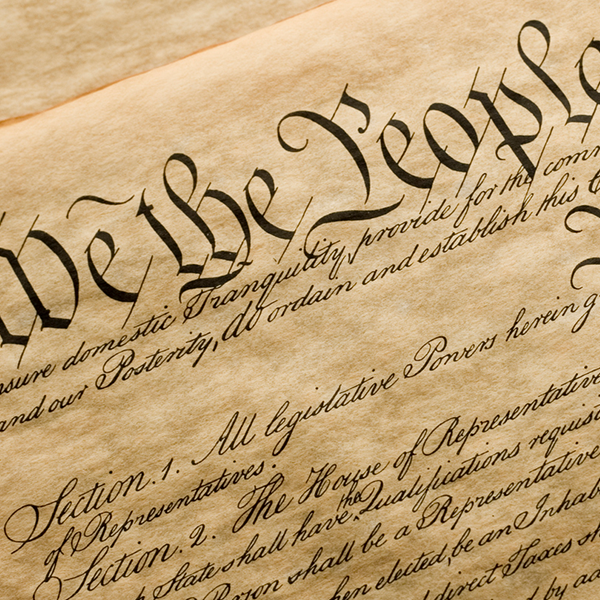Editors Note: It is important to note that even those impeachment processes that do not end in a conviction and removal from office by the Senate, including the now three presidential impeachments in our history, the “impeached” descriptor will forever attach to the official. A determination made by the House that there is enough evidence to impeach is not simply erased by the Senate’s determination that the evidence does not warrant conviction and removal from office.
A Citizen’s Guide to Impeachment, by Barbara Radnofsky. New York: Melville House Publishing. September 2017. ISBN: 978-1612197050. 160 pages.
Author Note
Wendy M. Rohleder-Sook, Assistant Professor and Director of Pre-Law/Legal Studies, Department of Political Science, Fort Hays State University.
High crimes and misdemeanors. We hear this phrase—outlined in the U.S. Constitution—used by politicians and news media when discussing impeachment, but what conduct is included in high crimes and misdemeanors? Must it be a serious crime? A misdemeanor? What is the process surrounding this phrase? A Citizen’s Guide to Impeachment, by Barbara Radnofsky, provides useful guidance in understanding the impeachment process, its historical background, and key lessons from the formal impeachment proceedings held throughout U.S. history. As the title suggests, the book is intended to serve as a “guide for citizens in a participatory government,” and it meets that goal in fine fashion.
Structure
The three chapters that make up A Citizen’s Guide to Impeachment include a discussion of the origins of impeachment law, a discussion of the legal principles and process of impeachment, and summaries of the formal impeachment proceedings conducted in the United States. The first chapter on the origins of impeachment law describes the Founding Fathers’ reliance on their knowledge of and experience with English law and their predictions of potential dangers posed by future leaders. These dangers include incapacity/negligence, tyranny, corruption, betrayal of trust to a foreign power, and treason. In the U.S. Constitution and accompanying Federalist Papers, the authors addressed the nature of the impeachment process, to whom it applied, the type of conduct it covered, and safeguards for both the process and the accused.
Chapter 2 pertains to the legal principles and congressional process of impeachment, including the House of Representative’s role in initiating the impeachment inquiry, conducting an investigation, and voting on any articles of impeachment presented to the full chamber. If any article is passed by a simple majority, the process moves to the Senate for trial and a final verdict. If convicted, the official is automatically removed from office. The Senate can hold a separate vote to determine if the official is disqualified from future office.
This chapter also offers an interpretation of the high crimes and misdemeanors clause of the U.S. Constitution. While treason and bribery are also listed as impeachable offenses in the Constitution, they have not been identified as frequently as high crimes and misdemeanors in impeachment articles, nor do they garner the same questions regarding interpretation. The high crimes and misdemeanors clause applies to both officers of the executive branch as well as federal judges. It does not require criminal intent, an actual crime, or a violation of a law or the Constitution; rather, the clause has been broadly defined and can include conduct that violates the public trust. Whether the conduct poses a substantial harm or risk of harm to society is a critical factor in determining if it passes the high crimes and misdemeanors test.
It is helpful to examine presidential conduct subject to impeachment in light of the president’s responsibilities to faithfully execute the law and the Office of the President, and to preserve, protect, and defend the Constitution. Abusing power, violating citizens’ rights, and acting in derogation of other constitutional powers are prohibited. Further, the impeachment process is protected from presidential pardon—of oneself or someone else.
The last chapter of A Citizen’s Guide to Impeachment details the facts, results, and key lessons associated with each of the 19 formal impeachment processes conducted in the United States. Sixteen of the formal proceedings have concluded with a Senate verdict, and all eight Senate convictions involved the impeachment and removal of federal judges. These cases serve as valuable precedent for interpreting the impeachment clause, providing guidance for future proceedings. Many of the key lessons relate to the type of conduct that satisfies the high crimes and misdemeanors test, including the accepted premise that the conduct does not have to be criminal in nature. Conversely, not all crimes are impeachable. There continues to be a preference for bringing articles of impeachment under the high crimes and misdemeanors clause even if the questionable conduct could be considered treason or bribery. The broader scope and lesser burden of proof for high crimes and misdemeanors is favored. In considering whether conduct meets the high crimes and misdemeanors standard, the Senate has affirmed the potential for substantial harm or risk to society as a major determinant.
The book identifies several examples of impeachable presidential conduct from President Nixon’s impeachment inquiry, including responsibility for the actions of subordinates, responsibility for occurrences they “have reason to know,” even if actual knowledge does not exist, misleading the public, violating constitutional principles (e.g., infringing on powers of other branches, interfering with investigations, withholding information, etc.).
Previous cases have established that intent is not required for an impeachment conviction, and both abuse of power for financial or personal gain, as well as personal conduct can qualify as impeachable offenses. Additional lessons relate to the process itself, affirming that impeachment is not a criminal legal process and only allows for the removal from office and disqualification from future office, and that the Senate’s deliberative nature makes it the body best-suited to conducting the trial.
Potential Applications
There are several excellent possibilities for applying the principles of A Citizen’s Guide to Impeachment: aiding the citizenry in understanding the impeachment process; guiding university instructors and administrators in facilitating discussions with students; and contributing to the dialogue between a university and its surrounding community.
First, in a very basic way, this book can help people understand the impeachment process. For example, since impeachment is a political process, rather than a criminal or legal one, it does not have to meet the same legal standards as a court proceeding. The two-step process originates in the House and ends in the Senate. If an article is passed by a simple majority in the House, the official is “impeached.” However, the Senate must convict by a two-thirds super majority (or 67 votes) in order for the official to be removed from office.
Second, the book can serve as a guide for university discussions between and among students and faculty, extending beyond the classroom to forums and informal conversations. Educators interested in not only increasing civic literacy but civically engaging students have an obligation to lead and support conversations with their students. While political science is an obvious discipline in which to hold these discussions, academic units in history, sociology, international relations, criminal justice, and psychology may also offer opportunities for such dialogue. Further, educators and administrators involved in civic leadership/education, student government, and various student affairs areas may find this a helpful tool in educational programs and informal conversations.
A Citizen’s Guide to Impeachment can also serve as a useful resource for explaining how the impeachment process works and for guiding students through critical-thinking exercises. Because this is a unique process that has been used in a very limited number of instances in U.S. history, many students have a limited understanding of how the impeachment process works in the context of the three branches of government.
While impeachment is not a criminal legal process, one may draw several parallels between the two. The House initiates the impeachment inquiry, deciding whether there is enough evidence of conduct that rises to the level of high crimes and misdemeanors to pass articles of impeachment. This parallels a grand jury’s role in considering whether to indict an individual, formally accusing them of committing a crime. If any articles of impeachment are passed in the House, the Senate conducts a trial, with the Chief Justice of the U.S. Supreme Court presiding. The Senate’s role is similar to a court and jury, and the Chief Justice’s role aligns with that of a judge in a legal proceeding. Even though the Chief Justice presides over the impeachment trial, the Supreme Court cannot review the Senate’s decision and is otherwise uninvolved in the process. Unlike a trial in the legal system, there is no appeal of a Senate impeachment verdict; the verdict is final. While House members serve as prosecutors in presenting the case to the Senate, the format does not have to follow a judicial-style trial. In addition, even if the impeachable offenses are criminal in nature, the Senate separates itself from the criminal process by requiring independent proof.
The forethought of the Founding Fathers in distributing the impeachment process across the two houses, and specifically giving the Senate the power to convict, was validated in early impeachment cases. The Senate’s deliberations confirmed that it is best-suited to conduct an impeachment trial because it can put partisan allegiances aside. Furthermore, the required two-thirds majority vote for conviction necessitates bi-partisan support. In contrast to a simple majority vote requirement, the super majority requirement of 67 votes also prevents the vice president, who can only vote to break a tie, from casting a deciding vote that would allow them to succeed to the presidency. Additionally, senators fully understand the potential harm to the separation of powers if the process is abused. Lastly, the Senate’s flexibility in format is better suited for this type of process than following the strict legal process required by the courts.
Third, this book can assist faculty in providing information to university and local communities. As citizens strive to better understand the impeachment process and accompanying standards of conduct, educators have an important role to play. Educational programming, such as presentations and forums, offers important opportunities for educators to extend civic education beyond their student populations. Additionally, as universities endeavor to improve or maintain town and gown relationships, this programming generates prospects for interaction and dialogue between the two communities.
A Citizen’s Guide to Impeachment is written in lay terms that clarify the impeachment process and highlight its significance to the separation of powers of the three branches of government. As stated in its conclusion, the essential lesson to take from the book is the importance of participating in democracy. One of the best and most significant ways to do so is to be informed and to vote.
Limitations
True to its title, A Citizen’s Guide to Impeachment does not embrace an academic or scholarly examination of questions of constitutional or statutory interpretation, case law, or technical issues related to impeachment. Therefore, it does have limitations for scholarly use beyond its intent to serve as a helpful resource for citizens and educators for the basic purposes mentioned earlier.
Another limitation of the book is its lack of discussion of the politics of the process itself. Decisions to move forward with a formal impeachment inquiry, pass articles of impeachment, and vote on a verdict are not made in a vacuum. Therefore, it is essential to consider the political environment in which these decisions are made. In today’s environment, opposing political parties control the chambers of Congress, and it is unknown whether congressional members will break party lines to support or refute possible articles of impeachment. Political polarization has increased dramatically over the past few decades, making it more challenging for individuals to break party lines, lest they face significant consequences. Consequently, as Democrats hold a majority in the House and Republicans hold a majority in the Senate, there is a distinct possibility that a Senate verdict could further solidify the partisan divide as the United States enters the 2020 general election campaign. Congressional votes are likely to have significant and immediate consequences. The impeachment process affords a mechanism for safeguarding the Constitution; however, these potential outcomes underscore the fact that it is a political process with political consequences.
Although understanding the impeachment process and studying prior impeachment cases as a sort of roadmap for current proceedings is helpful in guiding conversations, modern technology, the 24-hour news cycle, social media, and increasing difficulties in evaluating media credibility contribute to feelings of uncertainty. Though A Citizen’s Guide to Impeachment can help citizens understand the impeachment process, it cannot help them traverse a highly unpredictable political environment. Citizens must make informed decisions and be their own best advocates, rather than deferring to elected officials to fill that role.
Author
 Wendy Rohleder-Sook is an Assistant Professor and Director of Pre-Law/Legal Studies in the Department of Political Science at Fort Hays State University (FHSU). She holds a Bachelor of Arts degree in Political Science and Sociology from the University of Kansas (KU) and a Juris Doctor degree from the KU School of Law. During her twenty-year career in higher education, Wendy has worked as the Associate Dean for Student Affairs at the University of Kansas School of Law and Director of Financial Assistance at FHSU. She teaches various political science and legal studies courses, including current political issues, introduction to the law, legal research methods, legal advocacy, and American civil liberties.
Wendy Rohleder-Sook is an Assistant Professor and Director of Pre-Law/Legal Studies in the Department of Political Science at Fort Hays State University (FHSU). She holds a Bachelor of Arts degree in Political Science and Sociology from the University of Kansas (KU) and a Juris Doctor degree from the KU School of Law. During her twenty-year career in higher education, Wendy has worked as the Associate Dean for Student Affairs at the University of Kansas School of Law and Director of Financial Assistance at FHSU. She teaches various political science and legal studies courses, including current political issues, introduction to the law, legal research methods, legal advocacy, and American civil liberties.
Additional Resources on Impeachment
Books
- Impeachment: A Citizen’s Guide, Cass R. Sunstein
- Impeachment: A Handbook, New Edition, Charles L. Black, Jr.
- Impeachment: An American History, John Meacham, Timothy Naftali, Peter Baker, & Jeffrey A. Engel
Online Resources
- Impeachment Inquiry: Latest Updates for Students (PBS Newshour Extra) – https://www.pbs.org/newshour/extra/daily-videos/impeachment-inquiry-how-to-examine-the-issue-with-your-students/
- The Presidential Impeachment Process (infographic) – https://creately.com/blog/presidential-impeachment-process/
- Impeachment (History, Art, & Archives, United States House of Representatives) – https://history.house.gov/Institution/Origins-Development/Impeachment/

